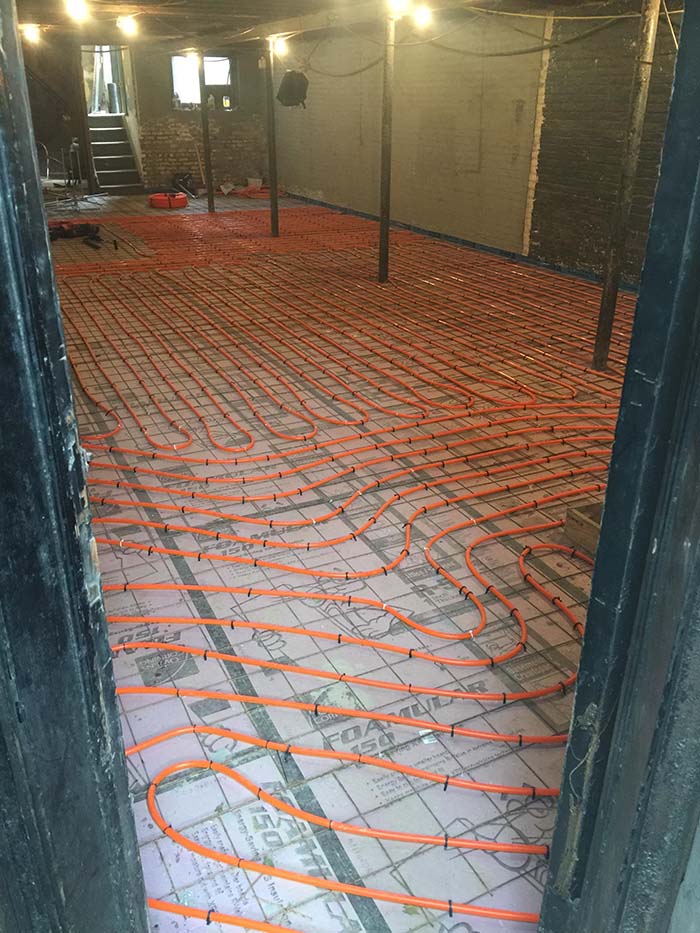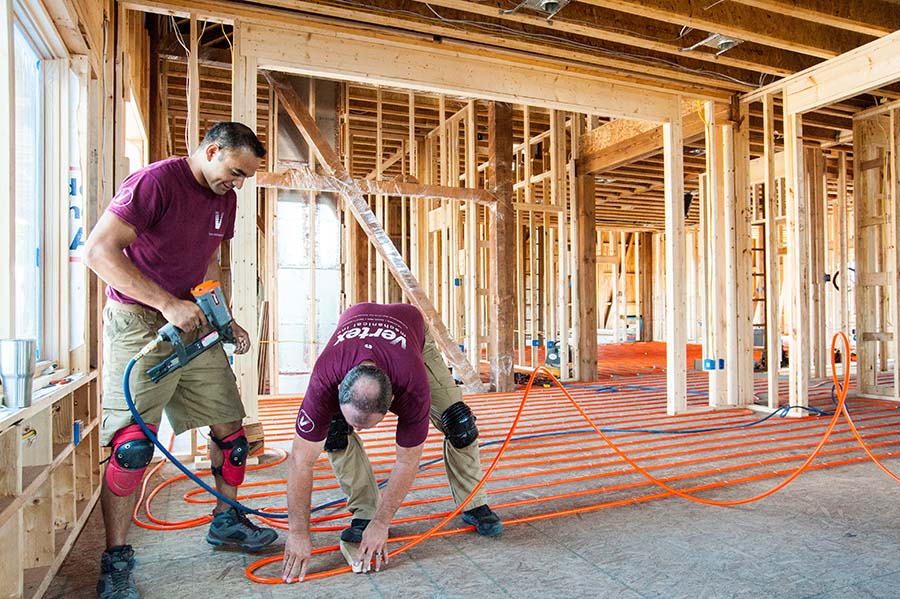There’s the typical HVAC installation — and then there’s the installation that’s not so typical, more than interesting, and requires a unique application. The ones that happen in a flight simulator facility where outdoor temps dip below -20 F; or in the conversion of an Amish barn to a family home; or in the renovation of a city landmark, like a Brooklyn limestone townhouse built in the 1800s that offers very little space to install a payphone, let alone an entire HVAC system.
Top Gun: HVAC
Before the Air Force’s elite pilots get actual air time in a Raptor, they must undergo hundreds of hours of classroom instruction and training specific to that aircraft. Think: Top Gun.
In 2011, the U.S. Airforce 3rd Wing expanded its fighter jet capacity at Joint Base Elmendorf Richardson (JBER) in Anchorage, Alaska with the addition of a 23,000-square-foot facility, where pilots would receive their final training before flying a Raptor.
With outdoor ambient temps dipping below -20°, and heavy computer infrastructure inside the building creating a large cooling load, the HVAC system installed needed to be variable, robust, and long-lived. Weldin Construction heated and constructed the entire facility, doing almost everything from pouring slab to installing plumbing fixtures, said Steve Nazaroff, mechanical division manager at Weldin Construction in Las Vegas, Nevada.
To heat the facility, hit consumption challenges head on, and meet building requirements, Nazaroff chose to use the Taco LoadMatch hydronic system.
“It’s self-balancing, reducing many start-up, commissioning, and operational problems, since all zones get their required amount of flow at all times,” said Nazaroff.
The design of the building started in 2008, but it was a challenge for Weldin to get the installation plans approved. Taco LoadMatch was very new at the time, and the government had never seen a heating system like it. Plus, there’s some sort of nightmarish story about another single-pipe system at JBER, Nazaroff said. So, the government had to really be convinced.
Two 800 MBH gas-fired boilers are the BTU source for the F-22 Flight Simulator Facility. From the large boilers, water travels through the three-inch main out into the building. At most of the terminal units, ¾-inch lines tee off. The VAV boxes are supplied by 1-inch lines.
Military security required Weldin trucks to be identified, employee backgrounds checked, and ID tags for everything. The security system installed required no conductive material be used to pass through the foundation or walls of either facility, so polypropylene pipe was used for coolant, gas, and electric lines.
Small Space, Big Job
Limestone is heavily appreciated in up-and-coming towns, but it’s not the easiest material to install a/c in. The old structures of limestone homes make it difficult to run heating and piping lines while coordinating with general contractors, homeowners, and electrical contractors.
Plus, working with limestone means settings are attached.
“So it's really difficult doing plumbing, heating, HVAC in these homes — to find places to put stuff — all of these type of projects are really fine-tuned and well-coordinated to get everything done correctly,” said Michael Petri, owner and president of Petri Plumbing, Heating, Cooling & Drain Cleaning, located in Brooklyn, New York.
Petri designed the heating and plumbing system for one of these homes when the owners bought a boarded-up Brooklyn limestone townhouse and decided to renovate it. And in a Brooklyn limestone, “there’s not really that much room to run anything,” Petri said.
All the drainage, plumbing, and heating systems had to be replaced.
“It was a complete revamp,” Petri said. “The heating system was like fitting a quarter into a dime because they don’t give you much room to operate. So the challenge is getting from point A to point B without a lot of space.”
Petri had to think about how he’d get the lines from point A to point B, which is already challenging, while working on a historical home built in the 1800s, and make sure everything is “landmark approved.”
The other challenge was with the many variables in the application of the heating system.

RADIANT HEAT: Radiant heat surrounding the insulating boards allows for the entire basement to be heated. (Courtesy of Michael Petri)
“It wasn't just a straight heating system that operates at 180°. It had to accommodate domestic hot water, it had to accommodate HVAC coils, panel radiators, and radiant heat at the same time,” Petri said.
Once the basement floor was backfilled and cemented, Petri and his team put insulating boards down and ran radiant heat around it to heat the basement. For the upper floors, they used a combination of a staple-up radiant system and panel radiators, along with all the HVAC equipment having coils.
“So it was a lot of variables with this particular job … We were working in situations where you could hardly even get yours hand in,” Petri said.
The homeowner served as the general contractor for the project, and Petri used all high-efficiency Viessmann equipment and Grundfos circulating pumps, in addition to TOTO and Donbracht plumbing equipment, and Pensotti panel radiators for the renovation.
Working with a homeowner directly, especially on a home as unique as this, has its own set of challenges.
“It's just the logistics of working in homes like this,” Petri said. “I know what his expectations are, and they have to be exact. There is no room for error within. If you miss by an inch, you’re taking it all apart.”
President, Vertex Mechanical
0 to 100 Real Quick
It’s not often you hear of a customer say they’d like to convert an Amish barn, with no heating, into their family home. But Vertex Mechanical, located in Stevens, Pennsylvania, rose to the occasion when said opportunity presented itself and did just what said couple had asked — and then some. The Simons’ goal was to make the barn, originally built for animals, truly comfortable for people.
“It was a tall order, but we enjoy unique challenges,” said Vince Youndt, president of Vertex Mechanical.
Youndt saw that the barn could have radiant heating in the concrete below and upstairs by encasing radiant tubing within a poured gypcrete layer. Youndt and his team conceived a plan to provide hydronic radiant heating and geothermal cooling for majority of the lower floor and the 4,900 square feet of living space above it.

WARM UP: Laying down tubing to get the floor warm to the touch. (Courtesy of Watts)
To do this, Watts radiant tubing was installed to the upstairs OSB subfloor attached to massive floorboards.
“I especially appreciate that Watts radiant offers 1,200-foot spools of ½-inch RadiantPEX+ tubing — ideal for the many 300-foot loops used at the Simons’ project,” Youndt said. Watts stainless steel manifolds also provided great flexibility for any necessary flow adjustments.
Youndt’s heat load calculation for the Simons’ home came to 128,000 BTUs for space heating and domestic water.
Vertex Mechanical heated the space with a five-ton geothermal heat pump. Yondt then selected a hung boiler to meet winter’s supplemental heat needs, and a Bradford White 60-gallon indirect and a 40-gallon water heater to heat domestic water.
Taco’s ECM-powered 007e system circulators were chosen to control the eight comfort zones in the home. The circulators are each tied to tekmar 406 control, a great partner to zone valve-controlled hydronic zones, Youndt said. Taco’s tekmar 485 was also installed to give the Simon’s remote access to the home’s climate control.
Now, invisible warmth emanates from the floor and the Simons and their guests can shed their socks and shoes in the winter, turning what used to be a completely “uncomforted” environment into one all about it.



Report Abusive Comment